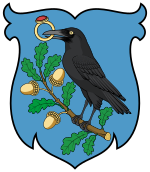Hunyad county
|
Hunyad County (Iron Market) (1910) |
|
|---|---|

|
|
| Administrative headquarters : | Déva |
| Area : | 7.809 km² |
| Population : | 350.135 |
| Ethnic groups : | 80% Romanians 15.5% Hungarians 2.5% Germans 0.5% Slovaks 1.5% others |

|
|
The county Hunyad [ huɲɒd ] (German rarely County Eisenmarkt ; Hungarian Hunyad vármegye , Latin comitatus Hunyadiensis , Romanian Comitatul Hunedoara ) was an administrative unit ( county , county ) of the Kingdom of Hungary . Today the area is in Transylvania in Romania .
Location and general
It bordered the counties of Arad , Torda-Aranyos , Lower Weissenburg (Alsó-Fehér) , Hermannstadt (Szeben) and Krassó-Szörény as well as the Kingdom of Romania to the south .
geography
The entire county is very mountainous due to its location in the southern Carpathians , in the south mountains rose up to almost 2500 meters ( Retezat Mountains ). Agriculture (grain, maize, fruit, wine) is only possible along the main river Marosch , which flows through the area alongside the Strell and Schil rivers , otherwise forestry and mining played an economic role.
history
Hunyad County was established in the 11th century and was mentioned as Hungnod in 1265 . It belonged to Transylvania , the easternmost part of the Kingdom of Hungary. The main seat of the county was Hunyad Castle , later the town of Deva became the administrative seat. After the occupation of Central Hungary by the Ottomans, the area became part of the Principality of Transylvania in the 16th century , and in 1711 it came with Transylvania, which was raised to the Grand Duchy in 1765 under Habsburg suzerainty. After the Austro-Hungarian Compromise , the county became part of the Kingdom of Hungary again in 1867 . During the county reform of 1876 it was merged with the Zaránd county and thus received new borders.
After the end of the First World War in 1918, the area became part of Greater Romania as a result of the Treaty of Trianon and is today in the Hunedoara district except for a narrow strip in the west that belongs to the Arad district .
District subdivision
In the early 20th century, the county consisted of the following chair districts (named after the name of the administrative center):
| Chair districts (járások) | |
|---|---|
| Chair district | Administrative headquarters |
| Algyógy | Algyógyalfalu, today Geoagiu |
| Brád | Brád, today Brad |
| Déva | Déva, today Deva |
| Hátszeg | Hátszeg, today Hațeg |
| Kőrösbánya | Kőrösbánya, today Baia de Criș |
| Marosillye | Marosillye, today Ilia |
| Petrozsény | Petrozsény, today Petroșani |
| Puj | Puj, today Pui |
| Szászváros | Szászváros, today Orăştie |
| Vajdahunyad | Vajdahunyad, today Hunedoara |
| City districts (rendezett tanácsú városok) | |
| Déva, today Deva | |
| Hátszeg, today Hațeg | |
| Szászváros, today Orăştie | |
| Vajdahunyad, today Hunedoara | |
All places are in today's Romania .
See also
literature
- Hunyad . In: Meyers Konversations-Lexikon . 4th edition. Volume 8, Verlag des Bibliographisches Institut, Leipzig / Vienna 1885–1892, p. 813.
Web links
- Entry in the Pallas Lexicon (Hungarian)
Individual evidence
- ↑ A magyar szent corona országainak 1910. évi népszámlálása . Budapest 1912, p. 12 ff.
- ↑ A magyar szent corona országainak 1910. évi népszámlálása . Budapest 1912, p. 22 ff. (1910 census)

